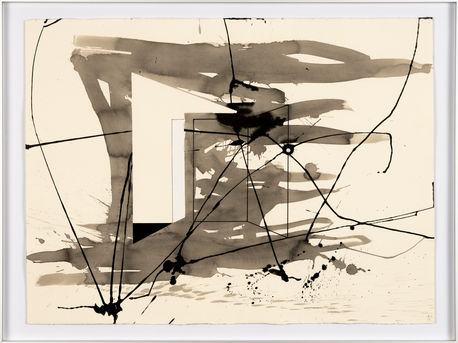
Rui Sanches
Os Espaços em Volta
14 FEBRUARY - 12 APRIL 2019
Interview
Exhibition View
Artworks
Exhibition Opening
Her work is featured in the following collections: Museu do Chiado, Serralves Foundation, Museu de Arte Contemporânea do Funchal, EDP Foundation, Coleção António Cachola and also the Coleção Banco Privado. She received the Prémio União Latina prize in 2001.From the principles of assemblage, intervened appropriation and abstract construction, the artist creates objects that appeal to the careful reading of their own processes, surprise and intrinsic nature. Isolated or conceived for dialogues in the space, they have the presence and the tactile appeal of sculpture, but also the resourcefulness of drawing and the intriguing challenge of their latent symbolic reference.
Among the one-person exhibitions we can single out: “Drawings”, CAM, Gulbenkian Foundation; “Body Building”, Loja da Atalaia, Lisbon; “Rui Sanches, Retrospective”, CAM, Gulbenkian Foundation and “Museum”, Museu Nacional de Arte Antiga, Lisbon. Some important group-exhibitions were: the 19th São Paulo Bienal; “PASTFUTURETENSE”, Winnipeg Art Gallery and Vancouver Art Gallery; “Tríptico”, Europália 91. Museum van Hedendaagse Kunst, Ghent; “From Silence to Light”, Watari-Um, Tóquio; “Abstract/Real”, Museum Moderner Kunst Stiftung Ludwig, Viena; “Dentro y Fuera” Cáceres and “Serralves 2009 – The Collection”, Museu de Serralves, Porto. During the 1980’s his work was based on the deconstruction of paintings and genres of painting.
Patrícia Garrido graduated in painting at the Escola Superior de Belas-Artes in Lisbon (ESBAL). She has participated in numerous group exhibitions which include: Mais Tempo, Menos História, Serralves Foundation, Porto (1996); O Império Contra-Ataca, Galeria ZDB, Lisbon (1998); Squatters, Galeria do CRUARB, Porto (2001). Solo exhibitions include: T1, Serralves Foundation, Porto (1998); Móveis ao Cubo, Desenhos ao Acaso, TREM Galeria Municipal de Arte, Faro (2009); Peças Mais ou Menos Recentes, EDP Foundation, Museu Nacional Soares dos Reis and Galeria Fernando Santos, Porto (2013).
Rui Sanches was born in Lisbon (1954) where he lives and works. He studied at Ar.Co, in Lisbon, at Goldsmiths’ College in London (B.A. 1980) and at Yale University in New Haven (M.F.A. 1982). He received a Gulbenkian Foundation scholarship for the period 1980/1982. His first one-person exhibition of drawings took place in Lisbon in the Modern Art Gallery of SNBA in 1984, soon followed by a first exhibition of sculpture in Galeria Diferença, in the same city. Since then he has shown his work in many galleries, museums and art centers, both in Portugal and abroad.
Artist Bio
Rui Sanches was born in Lisbon (1954) where he lives and works. He studied at Ar.Co, in Lisbon, at Goldsmiths’ College in London (B.A. 1980) and at Yale University in New Haven (M.F.A. 1982). He received a Gulbenkian Foundation scholarship for the period 1980/1982. His first one-person exhibition of drawings took place in Lisbon in the Modern Art Gallery of SNBA in 1984, soon followed by a first exhibition of sculpture in Galeria Diferença, in the same city. Since then he has shown his work in many galleries, museums and art centers, both in Portugal and abroad. Among the one-person exhibitions we can single out: “Drawings”, CAM, Gulbenkian Foundation; “Body Building”, Loja da Atalaia, Lisbon; “Rui Sanches, Retrospective”, CAM, Gulbenkian Foundation and “Museum”, Museu Nacional de Arte Antiga, Lisbon. Some important group-exhibitions were: the 19th São Paulo Bienal; “PASTFUTURETENSE”, Winnipeg Art Gallery and Vancouver Art Gallery; “Tríptico”, Europália 91. Museum van Hedendaagse Kunst, Ghent; “From Silence to Light”, Watari-Um, Tóquio; “Abstract/Real”, Museum Moderner Kunst Stiftung Ludwig, Viena; “Dentro y Fuera” Cáceres and “Serralves 2009 – The Collection”, Museu de Serralves, Porto. During the 1980’s his work was based on the deconstruction of paintings and genres of painting.
Artist Bio
He works with a total three-dimensionality, that of his sculptures as autonomous objects and external to the spectator and that of space as an involving topography and conducive to new experiences of aesthetic perception.
Paulo Henriques, Museum: Rui Sanches
Read Exhibition Paper





























